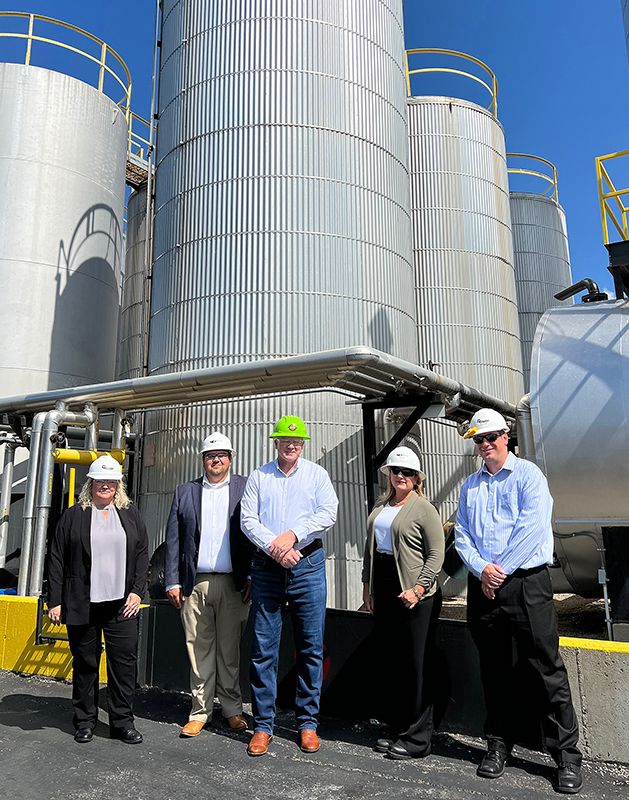
Rep. Warren Davidson (R-Ohio) visits the Terry Asphalt Materials Inc. terminal in Hamilton July 2023. From left are lab manager Patti Allen, regional manager Mike Szymborski, Rep. Davidson, HR manager for Barrett Industries Amanda Chaffin, and terminal manager Andrew Sigafoos
Whether you choose to contact your elected officials in their offices on Capitol Hill, in their states or districts, during a field site or manufacturing plant visit, or just by mail, e-mail or telephone, here are some thoughts to bring up with your elected officials when advocating for pavement preservation.
When contacting your elected officials, either in person with the legislator or his or her assistant, or by first class mail or e-mail, always start by explaining your personal connection to them.
For example, do you live or work in their state or district? If you have a facility in the state or district explain how many people work there. Working with state or local agencies have you had successful projects in their state or district? Discuss those and explain the benefits of a long-term highway reauthorization bill and how it affects them.
Then it will be time to talk about the issue!
FP2 and its allies work to retain and enhance pavement preservation provisions in surface transportation reauthorization bills which come before Congress.
Pavement preservation was eligible for funding in the MAP-21, the FAST Act, and now the 2021 Infrastructure Investment and Jobs Act (IIJA), which includes a five-year surface transportation reauthorization. It’s essential that this eligibility is retained in future surface transportation reauthorizations. That’s because pavement preservation practice extends pavement life, lowers the life-cycle cost, and avoids high future costs of reconstruction or rehabilitation through the expenditure of less money at critical points in a pavement life.
- Pavement preservation is an important tool used to extend public agency resources to increase the useful life of roads at a significant financial and environmental cost savings over the life of the road. Research shows spending $1 to preserve a road in good condition precludes spending $6 to $10 to reconstruct it later, after it’s gone too far to maintain.
- By preserving and extending the life of pavement, thus deferring the need for costly rehabilitation and reconstruction projects, federal highway dollars will go farther, less roadwork disruption will be created for the motorist, and the environment will benefit by decreased emissions from traffic jams, construction equipment and other environmental impacts.
- Extending limited federal, state and local dollars available for road infrastructure via pavement preservation remains important because even with the substantial IIJA investment in infrastructure, IIJA is insufficient to bring our road network to acceptable condition levels.
- Passage of the five-year surface transportation reauthorization in the IIJA facilitates the type of long-term planning which enables agencies to maximize their resources by effectively implementing their asset management plans and enabling them to utilize tools such as long-term pavement preservation strategies to meet their plan goals. By using these tools they can maintain their network assets in the best condition at lower lifetime financial and environmental costs.
- The financial certainty for transportation agencies achieved with a multi-year reauthorization, like that in the IIJA, enables agencies to focus on long term preservation and resilience of their roads, rather than the more short-sighted “worst first” approach, in which maintenance cash is spent fixing immediate problems, rather than planning to prevent future problems.
FP2 Inc. Fights for Pavement Preservation
- On Capitol Hill, FP2 represents all facets of the pavement preservation community. FP2 has corporate and association supporters. Pre-eminent among its association supporters are the Asphalt Emulsion Manufacturers Association, Asphalt Recycling & Reclaiming Association, International Grooving & Grinding Association, International Slurry Surfacing Association, and National Asphalt Pavement Association.
- In addition to its work “inside the Beltway” FP2 is very involved in supporting regional pavement preservation partnerships and councils, and the National Center for Pavement Preservation, all of which help promote wise use of limited dollars by preserving roads.
- FP2 also supports practical field research and development, such as the National Preservation Experiment collaborative research by the National Center for Asphalt Technology, and Minnesota DOT’s MnRoad test tracks, which are pioneering research in pavement preservation performance in different climates, while reducing duplication of state efforts.
Please Reach Out to Your Elected Officials!
Please reach out to your representative and two senators to urge them to support policies promoting adequate funding for pavement preservation and associated research. Use of these themes will make your outreach easier and ensure a consistent message from the pavement preservation community.
For more information, please contact FP2 executive director Rick Church, 630.230.1397, rickc@cmservices.com.
Please download the advocacy tools below to use when hosting or meeting with your elected officials
FP2 Toolkit for Hosting Elected Officials
2025 Combined Congressional Calendar
Talking Points for a Visit to Elected Officials
Charts to Use During Your Visit
State-Specific Road System Conditions and Needs from TRIP, The Road Information Program
(Members of Congress find these data very useful as you spotlight needs of their state)
Template Letter to Your Member of Congress
Template for Congressional Site Visit Invitation
The off-site links below can be used to find your representative and senators. The best way to contact them is through e-mail. District meeting or site visit requests are best scheduled through the closest in-state office. If you need help accessing that information, please let Rick Church (rickc@cmservices.com) or Tracy Taylor (tracy.taylor@align-strategies.com) know and we will be glad to help.
Find your U.S. Senators
https://www.senate.gov/general/contact_information/senators_cfm.cfm
Find your U.S. House Representative
https://www.house.gov/htbin/findrep
